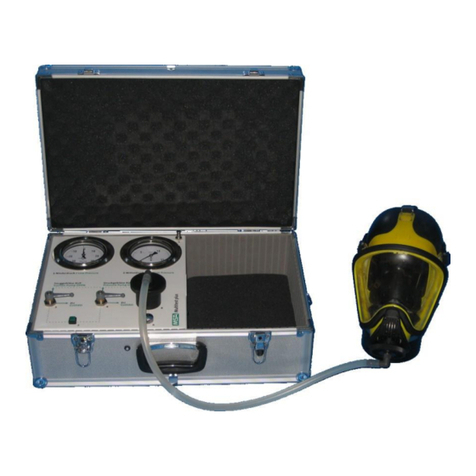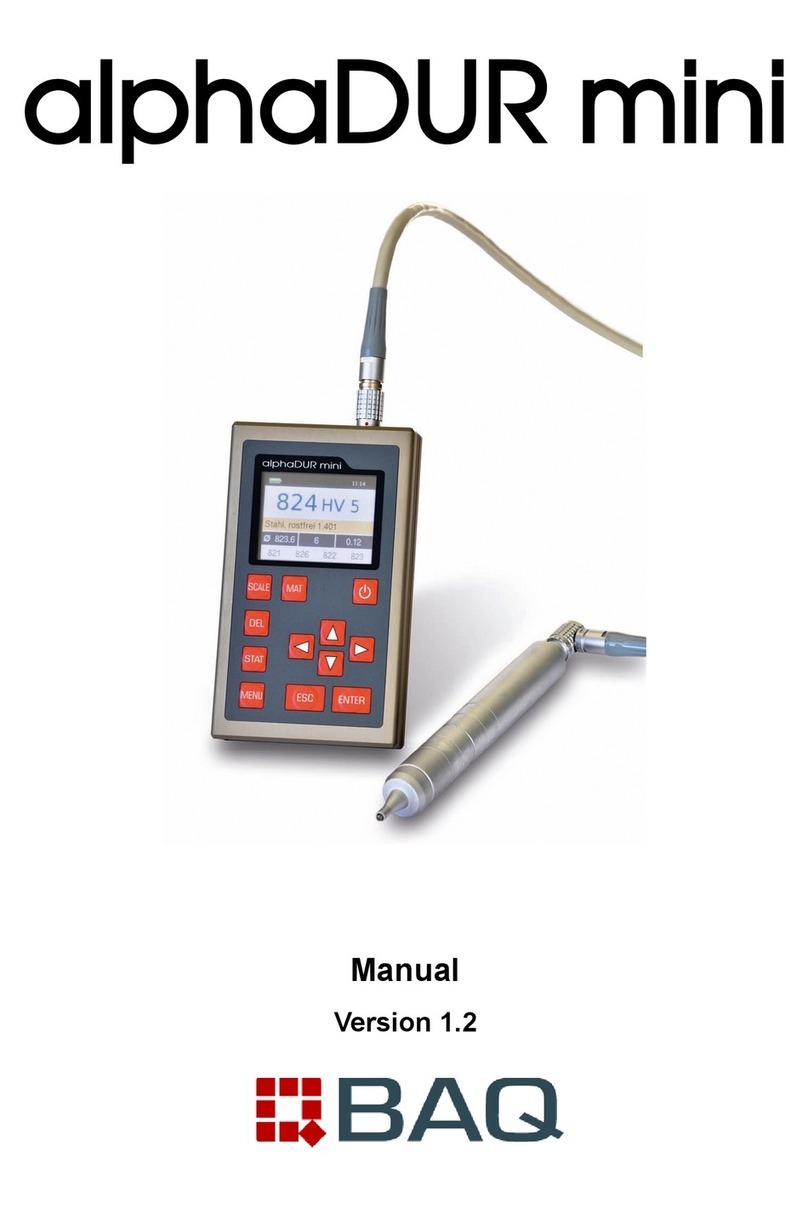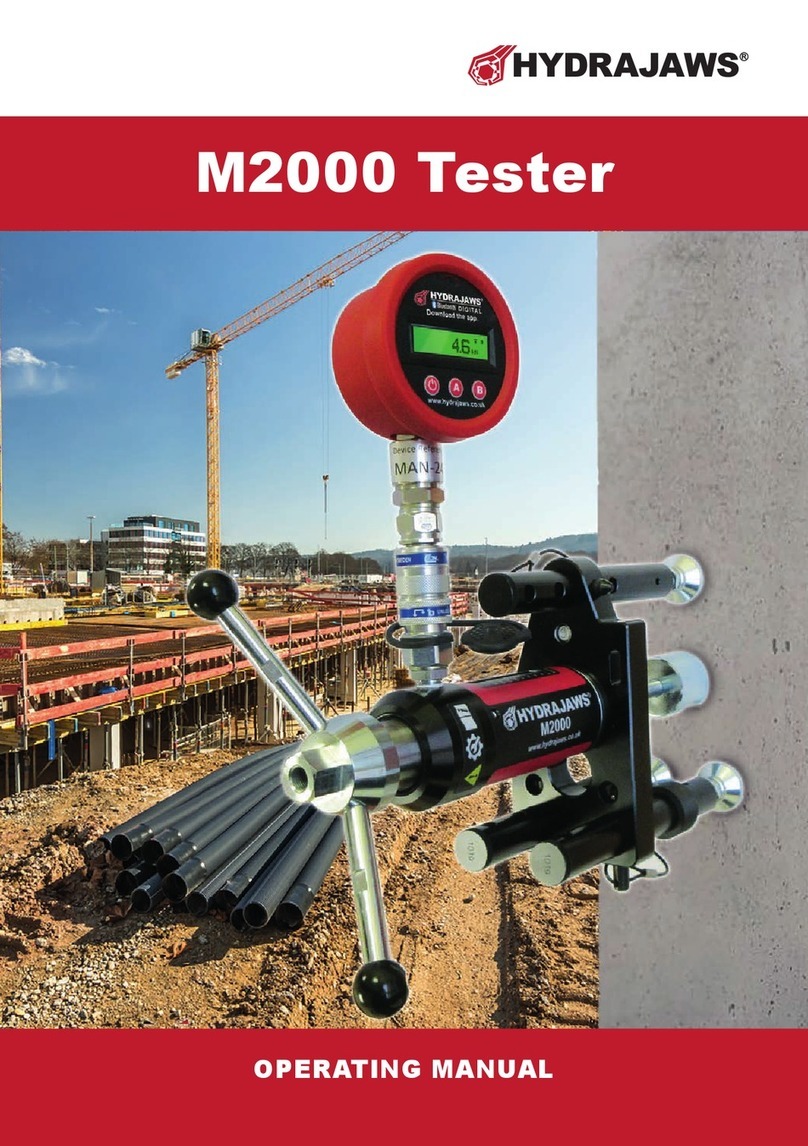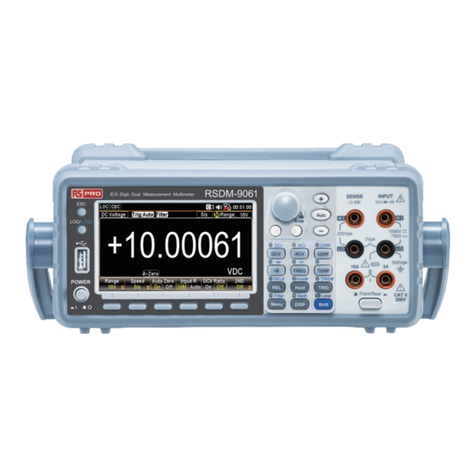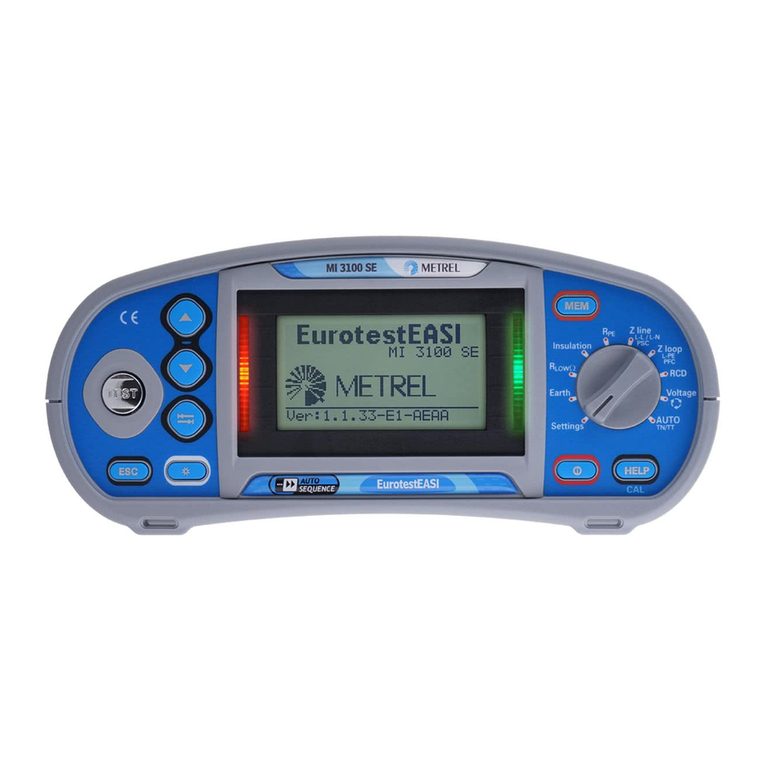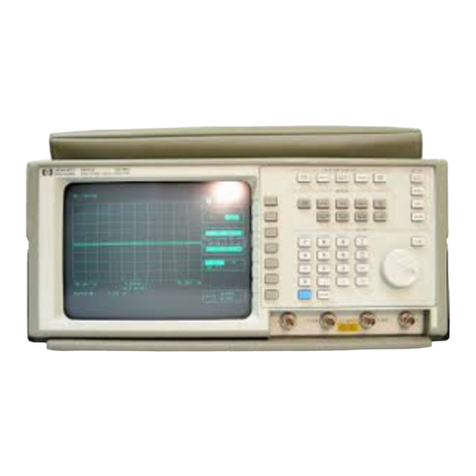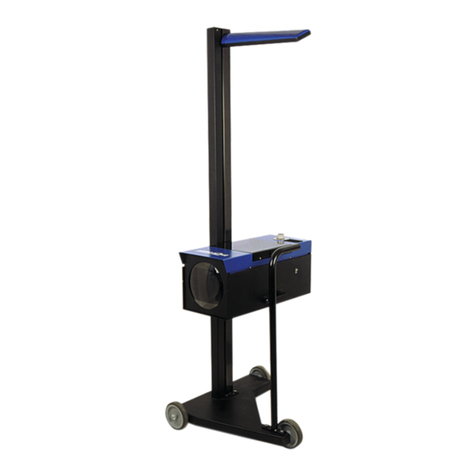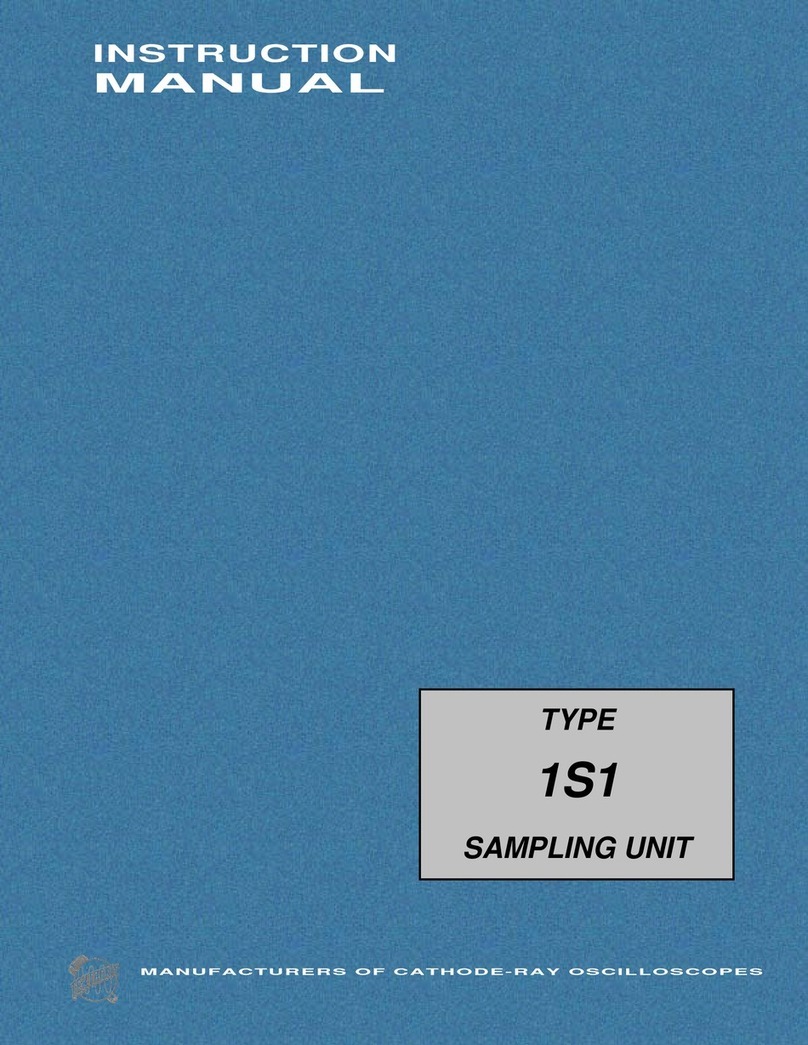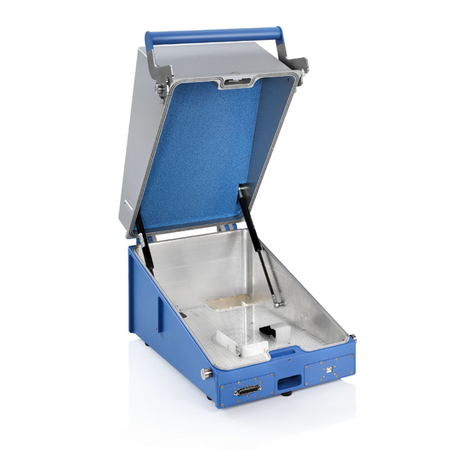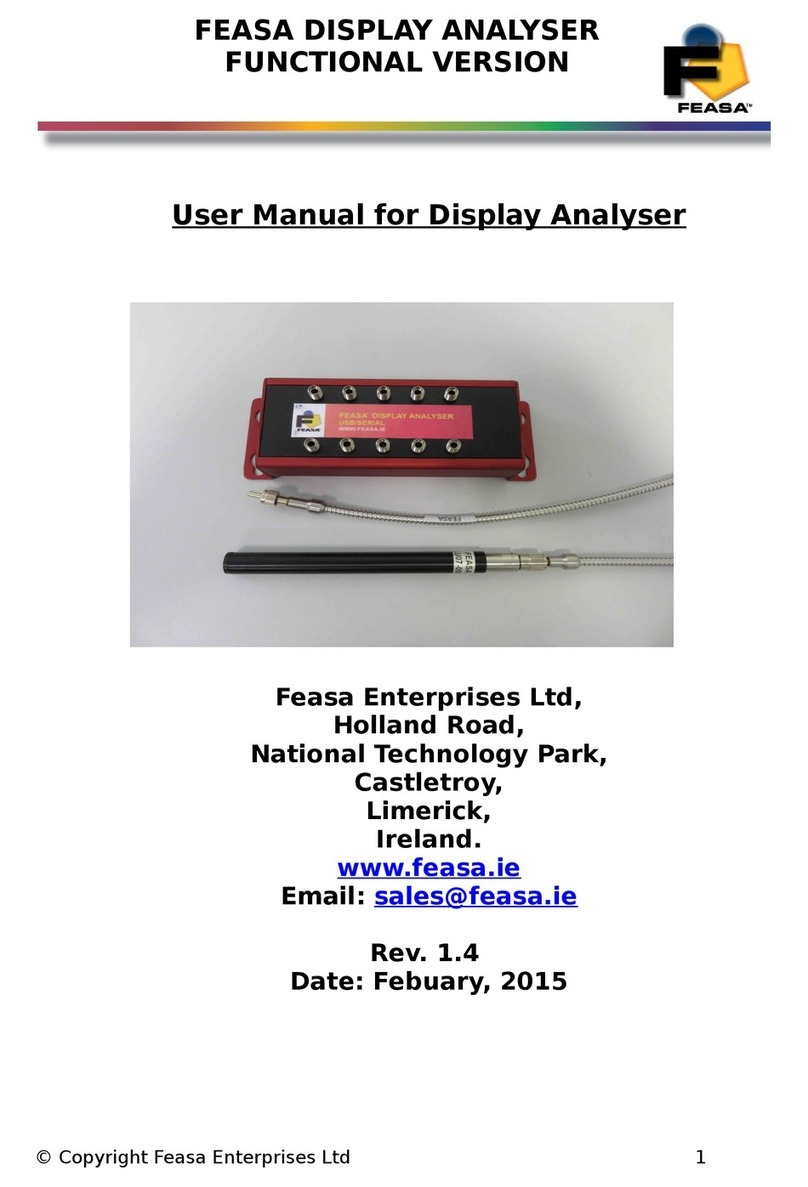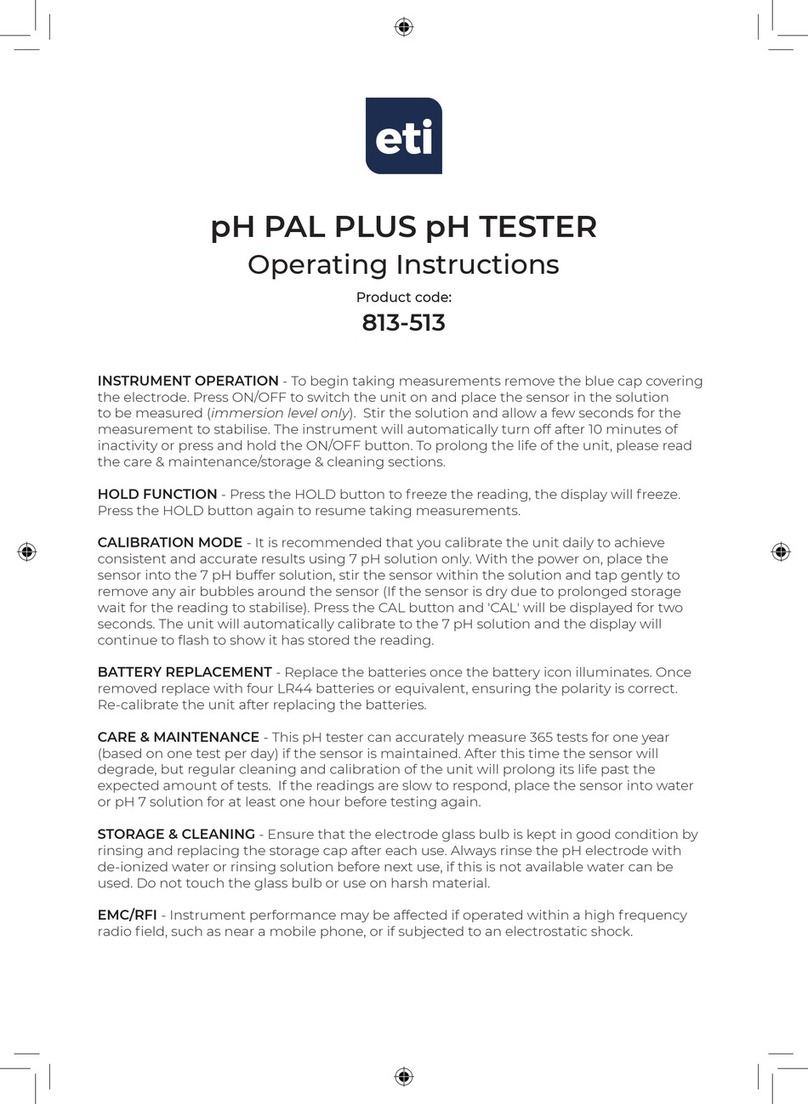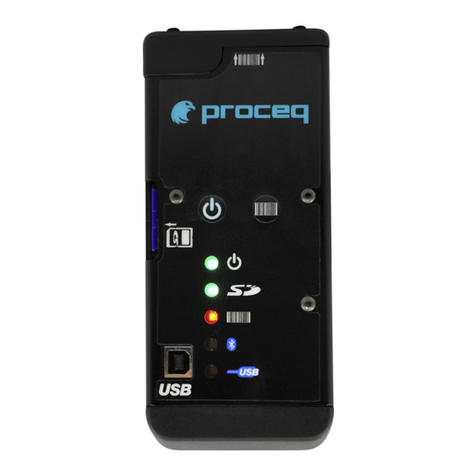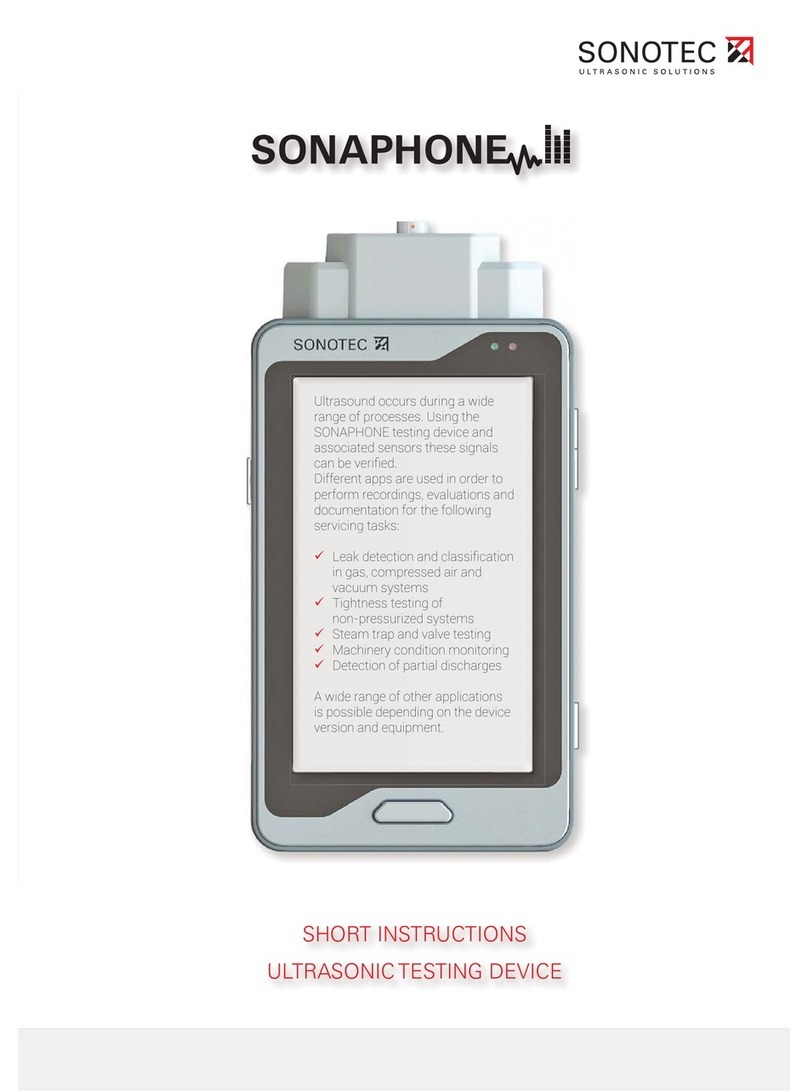MENZL Multitest ND User manual


Multitest ND
Operator's manual
-3-
Contents
Operating and safety instructions............................................................................................................5
General remarks..................................................................................................................................5
Remarks on performing tests..............................................................................................................5
Operating environment.......................................................................................................................5
Malfunction and excessive strain........................................................................................................5
Testing and maintenance ....................................................................................................................5
Care and cleaning ...............................................................................................................................5
Accessories.........................................................................................................................................6
Specifications..........................................................................................................................................7
Scope of delivery................................................................................................................................7
Controls ..............................................................................................................................................8
Introduction.............................................................................................................................................9
The tester ............................................................................................................................................9
Features of the tester...........................................................................................................................9
Scope of possible tests........................................................................................................................9
Performing tests....................................................................................................................................10
Important note on performing tests...................................................................................................10
Normal-pressure equipment..............................................................................................................10
Lung-governed demand valve—leak-tightness without positive medium pressure.....................10
Lung-governed demand valve—leak-tightness without negative medium pressure....................11
Lung-governed demand valve—leak-tightness with medium pressure .......................................11
Lung-governed demand valve—opening pressure.......................................................................12
Mask—leak tightness...................................................................................................................12
Positive-pressure equipment.............................................................................................................13
Lung-governed demand valve—leak-tightness without positive medium pressure.....................13
Lung-governed demand valve—leak-tightness with medium pressure .......................................13
Lung-governed demand valve—closing pressure........................................................................14
Mask—leak tightness...................................................................................................................14
Mask—exhalation-valve opening pressure..................................................................................15
Chemical protective suit...................................................................................................................15
Preparing the suit for testing ........................................................................................................15
Letting the suit pressure stabilize.................................................................................................15
Chemical protective suit—valve testing ......................................................................................16
The dummy head...................................................................................................................................17
Inserting/replacing the battery ..............................................................................................................18
Accessories ...........................................................................................................................................19


Multitest ND
Operator's manual
-5-
Operating and safety instructions
General remarks
The health and lives of people may depend on this tester. All persons who make decisions
regarding its use, who operate, service and maintain it or who check whether it is fully
functional must thoroughly and carefully read, understand and follow the instructions in this
operator's manual. The tester has been tested and has left the factory with all features in
perfect working order.
The information provided in this manual is subject to change without notice. Errors and
omissions excepted.
Remarks on performing tests
Do NOT use thetester for performing tests on pieces of equipment other than those mentioned
in this manual. Never apply medium pressure to a lung-governed demand valve while it is
attached to the tester’s equipment connector. Otherwise, the low-pressure gauge and/or the
lung-governed demand valve may get damaged. For more information on how to test
equipment, please refer to the relevant sections of this manual.
Operating environment
Set the tester up in a dust-free location with as little fluctuations in ambient air temperature
and humidity as possible. Avoid direct exposure to sunlight because it may have a negative
impact on the tester’s accuracy.
Malfunction and excessive strain
Whenever it is likely that the tester is no longer safe for use, make it inoperative and secure it
against any unintentional operation. A service representative of the manufacturer, or a
similarly trained and authorized person, is to diagnose and remedy the cause of malfunction.
Testing and maintenance
The tester itself needs to be tested annually to ensure that it is fully functional and leak-tight
at all pressure levels. Only original replacement parts, fitted by authorized persons, may be
used for repairs. Every 6 years, the tester is to be serviced and recalibrated by the
manufacturer. If the tester gets used a lot, it is recommended that you have it serviced and
recalibrated annually. Where there is a conflict with national provisions and requirements, the
national provisions and requirements shall prevail.
Care and cleaning
Remove dust by carefully wiping the tester's housing with a soft cloth. To get rid of more
stubborn dirt, use a soft, damp cloth and a mild cleaning solution. Never use scourers,
alkaline/acidic detergents, scouring powder or volatile solvents such as alcohol, petroleum
spirits, dilutions or insecticides for cleaning.
Storage
Store the tester at around 20 °C in a dry location that is free from dust and dirt. Keep the tester
protected from direct sunlight. If you do not use the tester for several weeks in a row, you
should remove the battery for environmental and safety reasons.

Multitest ND
Operator's manual
-6-
Accessories
Verify you have received all accessories included in the scope of delivery.

Multitest ND
Operator's manual
-7-
Specifications
Dimensions:
550 x 200 x 370 mm (w x h x d)
Medium-pressure compressed-air
connectors:
euro coupling
Power supply:
1.5V battery
Power adapter:
1.5V DC 1A
Weight:
10.00 kg
Gauge
Pressure range
Accuracy class
Low pressure
+/-20 mbar
1.6%
Scope of delivery
The scope of delivery includes:
•Multitest ND
•mask testing hose
•dummy head complete with filling valve
•adapters (may vary depending on the order placed)
•sealing plug for hose of lung-governed demand valve
•timer
•silicon spray
•1.5V battery (type D cell)
•operator's manual

Multitest ND
Operator's manual
-8-
Controls
1
low-pressure gauge
5
pump push-button
2
suction-pump lever
6
equipment connector
3
pressure-pump lever
8
battery compartment (on the side of the tester)
4
relief valve
9
jack for power adapter (1.5V)
20
dummy head
30
mask testing hose
21
push-button valve
30a
round thread to be attached to equipment
connector
22
relief valve for dummy head
30b
round thread to be attached to mask
23
clamp

Multitest ND
Operator's manual
-9-
Introduction
Constantly increasing demands with regard to the performance and operational safety of
respiratory protective equipment call for a sustained effort to continually optimize equipment
testers.
Combining pinpoint accuracy with utmost operator friendliness and a stylish design, the Menzl
“Multitest ND” tester meets all the requirements of state-of-the-art equipment testing.
The tester
The “Multitest ND” tester is suitable for testing respiratory protective masks and lung-governed
demand valves at low pressure. In its basic configuration, it can be used for performing tests
on pieces of normal-pressure equipment with round-thread connectors. Thanks to a wide
range of adapters (see accessories), it is also possible to test positive-pressure equipment as
well as different makes of chemical protective suits.
Features of the tester
One battery (type D cell) is required for operating the tester. A compressed-air supply is not
needed. Optionally, the tester can be powered via a 230V/1.5V mains adapter. The low
pressure for leak-tightness tests and functional tests is provided by the tester's built-in pump
and shown on the low-pressure gauge. Chemical protective suits get inflated via the filling
hose's push-button valve, which features a plug-in nipple that is compatible with the plug-in
safety coupling. The dummy head can be inflated with compressed air from either an SCBA
or a compressed-air supply line.
Scope of possible tests
- all leak-tightness tests, opening-pressure tests and closing-pressure tests
- all tests performed at low pressure
- all tests done with a suction pump or a pressure pump

Multitest ND
Operator's manual
-10 -
Performing tests
For the time intervals against which leak-tightness tests and functional tests are to be carried
out, refer tothe manual provided by the equipment manufacturer. Always perform tests against
the specifications found in the relevant equipment manual.
Important note on performing tests
Do NOT apply medium pressure to the lung-governed demand valve while it is attached to
the equipment connector.
Be sure to strictly adhere to the following sequence of steps in order to prevent the tester and the
lung-governed demand valve from being damaged:
- Detach the lung-governed demand valve from the equipment connector.
- Apply medium pressure to the lung-governed demand valve.
- Attach the pressurized lung-governed demand valve to the equipment connector.
Normal-pressure equipment
Lung-governed demand valve—leak-tightness without positive medium
pressure
Attach the lung-governed demand valve to the equipment
connector.
Seal the connecting nipple of the lung-governed demand valve.
Move the “pressure pump” lever to the “OPEN” position.
Press and hold the pump push-button.
Let the pressure build up until it is slightly higher than the level required
for testing and move the “pressure pump” lever to the “CLOSED”
position.
Release the pump push-button.
Release pressure via the relief valve until the level required for testing is
reached.
Perform the test against the specifications provided by the equipment
manufacturer.

Multitest ND
Operator's manual
-11 -
Lung-governed demand valve—leak-tightness without negative medium
pressure
Attach the lung-governed demand valve to the equipment
connector.
Seal the connecting nipple of the lung-governed demand valve.
Move the “suction pump” lever to the “OPEN” position.
Press and hold the pump push-button.
Let the pressure build up until it is slightly higher than the level required
for testing and move the “suction pump” lever to the “CLOSED” position.
Release the pump push-button.
Release pressure via the relief valve until the level required for testing is
reached.
Perform the test against the specifications provided by the equipment
manufacturer.
Lung-governed demand valve—leak-tightness with medium pressure
IMPORTANT: Be sure to strictly adhere to the sequence of steps!
Detach the lung-governed demand valve from the equipment
connector.
Attach the connecting nipple of the lung-governed demand valve to the
SCBA.
Open the breathing-air-cylinder valves.
Attach the lung-governed demand valve to the equipment
connector.
Move the “pressure pump” lever to the “OPEN” position.
Press and hold the pump push-button.
Let the pressure build up until it is slightly higher than the level required
for testing and move the “pressure pump” lever to the “CLOSED”
position.
Release the pump push-button.
Release pressure via the relief valve until the level required for testing is
reached.
Perform the test against the specifications provided by the equipment
manufacturer.

Multitest ND
Operator's manual
-12 -
Lung-governed demand valve—opening pressure
IMPORTANT: Be sure to strictly adhere to the sequence of steps!
Detach the lung-governed demand valve from the equipment
connector.
Attach the connecting nipple of the lung-governed demand valve to the
SCBA.
Open the breathing-air-cylinder valves.
Attach the lung-governed demand valve to the equipment
connector.
Move the “suction pump” lever to the “OPEN” position.
Press the pump push-button.
Perform the test against the specifications provided by the equipment
manufacturer.
Mask—leak tightness
Strap the mask onto the dummy head.
Connect the testing hose to the tester and the mask.
Move the “suction pump” lever to the “OPEN” position.
Press and hold the pump push-button.
Let the pressure build up until it is slightly higher than the level required
for testing and move the “suction pump” lever to the “CLOSED” position.
Release the pump push-button.
Release pressure via the relief valve until the level required for testing is
reached.
Perform the test against the specifications provided by the equipment
manufacturer.

Multitest ND
Operator's manual
-13 -
Positive-pressure equipment
Lung-governed demand valve—leak-tightness without positive medium
pressure
Attach the lung-governed demand valve to the equipment
connector.
Seal the connecting nipple of the lung-governed demand valve.
Move the “pressure pump” lever to the “OPEN” position.
Press and hold the pump push-button.
Let the pressure build up until it is slightly higher than the level required
for testing and move the “pressure pump” lever to the “CLOSED”
position.
Release the pump push-button.
Release pressure via the relief valve until the level required for testing is
reached.
Perform the test against the specifications provided by the equipment
manufacturer.
Lung-governed demand valve—leak-tightness with medium pressure
IMPORTANT: Be sure to strictly adhere to the sequence of steps!
Detach the lung-governed demand valve from the equipment
connector.
Deactivate the positive-pressure function of the lung-governed
demand valve.
Attach the connecting nipple of the lung-governed demand valve to the
SCBA.
Open the breathing-air-cylinder valves.
Attach the lung-governed demand valve to the equipment
connector.
Move the “pressure pump” lever to the “OPEN” position.
Press and hold the pump push-button.
Let the pressure build up until it is slightly higher than the level required
for testing and move the “pressure pump” lever to the “CLOSED”
position.
Release the pump push-button.
Release pressure via the relief valve until the level required for testing is
reached.
Perform the test against the specifications provided by the equipment
manufacturer.

Multitest ND
Operator's manual
-14 -
Lung-governed demand valve—closing pressure
IMPORTANT: Be sure to strictly adhere to the sequence of steps!
Detach the lung-governed demand valve from the equipment
connector.
Activate the positive-pressure function of the lung-governed
demand valve.
Attach the connecting nipple of the lung-governed demand valve to the
SCBA.
Open the breathing-air-cylinder valves.
Attach the lung-governed demand valve, with its positive-pressure
function activated, to the equipment connector.
Release pressure via the relief valve for 5 seconds.
Perform the test against the specifications provided by the equipment
manufacturer.
Mask—leak tightness
Strap the mask onto the dummy head.
Connect the testing hose to the tester and the mask.
Move the “suction pump” lever to the “OPEN” position.
Press and hold the pump push-button.
Let the pressure build up until it is slightly higher than the level required
for testing and move the “suction pump” lever to the “CLOSED” position.
Release the pump push-button.
Release pressure via the relief valve until the level required for testing is
reached.
Perform the test against the specifications provided by the equipment
manufacturer.

Multitest ND
Operator's manual
-15 -
Mask—exhalation-valve opening pressure
Strap the mask onto the dummy head.
Connect the testing hose to the tester and the mask.
Move the “pressure pump” lever to the “OPEN” position.
Press the pump push-button.
Perform the test against the specifications provided by the equipment
manufacturer.
Chemical protective suit
Preparing the suit for testing
Unfold the suit on a workbench or the clean floor.
Remove all valve chambers.
Remove all exhalation-valve disks.
Connect the testing hose to the exhalation valve.
Attach the testing hose to the tester's equipment connector.
Connect the filling hose to the exhalation valve.
Connect the filling valve to the medium-pressure supply.
Seal all other exhalation valves of the suit.
Letting the suit pressure stabilize
Use the filling valve to adjust the pressure to the level that is required for
testing according to the suit manufacturer.
CAUTION: Never increase the pressure in the suit beyond the
required stabilization pressure. Otherwise, seams and joints may
get damaged.
Perform the test against the specifications provided by the equipment
manufacturer.

Multitest ND
Operator's manual
-16 -
Chemical protective suit—valve testing
Connect the testing hose to the inside part of the valve.
Attach the testing hose to the tester's equipment connector.
Move the “suction pump” lever to the “OPEN” position.
Press and hold the pump push-button.
Let the pressure build up until it is slightly higher than the level required
for testing and move the “suction pump” lever to the “CLOSED” position.
Release the pump push-button.
Release pressure via the relief valve until the level required for testing is
reached.
Perform the test against the specifications provided by the equipment
manufacturer.
Repeat these steps for every single valve of the suit!

Multitest ND
Operator's manual
-17 -
The dummy head
General remarks
For optimal results during mask testing, inflate the dummy head to the size of a normal human head
(see images) via the filling hose mounted to the dummy head's base. The filling hose is equipped with
a push-button valve that can be connected to a medium-pressure supply (e.g. the medium-pressure
hose of an SCBA). Inflate the dummy head by pressing the push-button.
The dummy head is
insufficiently inflated.
The dummy head is ideally
shaped for testing masks.
The dummy head is inflated too
much.
CAUTION: Inflating the dummy head too much may damage it.
Taking care of the dummy head
In order to prevent premature wear and tear, protect the dummy head from direct exposure to sunlight
and cover it with a protective hood if it is not used for an extended period of time. Once a week, apply
plenty of silicon spray and let it work into the (uncovered) dummy head overnight.
Article number of silicon spray (500 ml) 1800-015

Multitest ND
Operator's manual
-18 -
Inserting/replacing the battery
The built-in battery compartment is located on the side of the tester. One battery (type D cell) is
needed for powering the tester's internal pump. To insert or replace the battery, proceed as
follows:
Remove the battery-compartment cover
Turn the battery-compartment cover to the left with a flat-blade screwdriver or a coin and remove it.
Replace the battery
Remove the empty battery and insert a new one. Always observe the correct polarity!
Put the battery-compartment cover back on
Put the battery-compartment cover back on and turn it to the right with a flat-blade screwdriver or a
coin to lock it in place.
Jack for power adapter
Next to the battery compartment, there is a jack for a power adapter (230 V AC / 1.5 V DC, 1A).
Always verify that the output voltage (1.5 V) and polarity of the power adapter are correct. Plug the
power adapter's DC cord into the tester's DC jack. The use of a power adapter automatically
disconnects the battery.

Multitest ND
Operator's manual
-19 -
Accessories
Adapters for
respiratory protective masks
MSA Auer plug-in connector
330-048
MSA Auer plug-in connector AutoMaXX
330-152
Threaded connector M 45x3
330-050
Dräger plug-in connector
330-049
Interspiro plug-in connector
330-051
Interspiro Clic
330-168
Plug-in connector ESA
330-178
Adapters for
lung-governed demand valves
MSA Auer plug-in connector
330-011
MSA Auer plug-in connector AutoMaXX
330-149
Threaded connector M 45x3
330-012
Dräger plug-in connector
330-013
Interspiro plug-in connector
330-014
Interspiro Clic
330-162
Plug-in connector ESA
330-175
Adapters for
chemical protective suits
MSA Auer testing adapter
330-335
Dräger testing adapter
330-295
Interspiro testing adapter
330-294
MSA Auer sealing adapter
330-164
Dräger sealing adapter
330-500
Interspiro sealing adapter
220-372
Dräger valve testing adapter
330-501
Interspiro valve testing adapter
330-502
Equipment for testing
chemical protective
suits (CPS)
Testing hose with connecting adapter for Auer CPSs
330-039
Filling hose with connecting adapter for Auer CPSs
330-041
Valve testing unit with valve testing adapter for Auer
CPSs
330-235
Fastening straps for
helmet-mask
combinations (HMC)
MSA Auer (old and new)
330-120
Heros
180-162
Dräger
330-210
HMC stainless steel
support
Main unit (MSA Auer, Dräger)
330-233
HMC MSA Auer old
330-127
HMC Heros
330-128
Other accessories
Protective hood for dummy head
340-001
Silicon service spray
1800-015
Medium-pressure hose with connectors 600 mm
330-202
Software
Please do not hesitate to get in touch with us if you have
any questions or would like to learn more about the
functionality of our software products, their range of
possible applications or their use in networked
environments.
Inventory management
330-005
Barcodes
Handheld barcode scanner
330-154
Base for handheld barcode scanner
260-044
Front-adhesive barcode labels (pack of 100)
330-220
Back-adhesive barcode labels (pack of 100)
330-219

Multitest ND
Operator's manual
-20 -
Cylinder pressure gauge
For checking the pressure levels of 200-bar and 300-
bar breathing-air cylinders. Easy to operate. Pull-back
depressurization mechanism.
330-023
Ultrasonic cleaner
For the optimal cleaning and disinfecting of masks and
lung-governed demand valves in a minimum of time.
Masks do not need to be disassembled. Comes
complete with an immersion basket and a lid.
for 2 masks
60-103
for 6 masks
330-148
for 9 masks
330-156
TM Speed mask drying cabinet
For drying up to 12 respiratory protective masks in
approximately 1 hour. All-automatic operation,
controlled by an adjustable timer. Masks are dried at a
maximum of 50 °C by means of a hot-air blower.
330-399
RDT 09 mask washing machine
For cleaning, disinfecting and drying up to 9 respiratory
protective masks in approximately 4 hours. PLC-
controlled, all-automatic operation. Disinfectant gets
added automatically. Freely adjustable concentration
level (0.5% to 5%). Masks are dried at a maximum of
50 °C by means of a hot-air blower.
330-487
Detergent EW80 clean
For cleaning respiratory protective masks, chemical
protective suits and gloves. Tested and approved for
use with Dräger and MSA Auer equipment by the
Deutsche Gesellschaft für Hygiene und Mikrobiologie
(German Society for Hygiene and Microbiology), testing
authority of DMT - Gesellschaft für Forschung und
Prüfung Gmbh.
1 litre
330-449
Disinfectant EW80 des
For disinfecting respiratory protective masks, chemical
protective suits and gloves. Tested and approved for
use with Dräger and MSA Auer equipment by the
Deutsche Gesellschaft für Hygiene und Mikrobiologie
(German Society for Hygiene and Microbiology), testing
authority of DMT - Gesellschaft für Forschung und
Prüfung Gmbh.
1 litre
330-417
5 litres
330-418
Metering unit DMZ 01
For adding a preset amount of disinfectant, detergent or
decontaminant. The concentration level can be freely
adjusted from 0.5% to 2%.
330-550
This manual suits for next models
1
Table of contents
Other MENZL Test Equipment manuals

